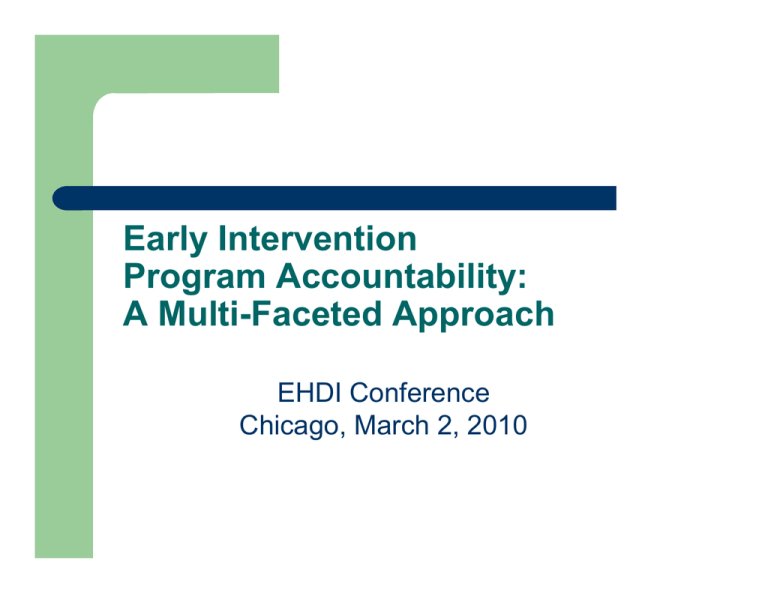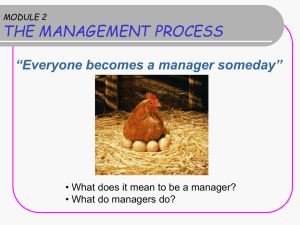Early Intervention Program Accountability: A Multi-Faceted Approach EHDI Conference
advertisement

Early Intervention Program Accountability: A Multi-Faceted Approach EHDI Conference Chicago, March 2, 2010 Presenters ¾Allison Sedey y University of Colorado-Boulder Colorado School for the Deaf and the Blind ¾Dinah Beams Colorado School for the Deaf and the Blind ¾Jennie Germano Colorado School for the Deaf and the Blind Today’s Agenda • Briefly describe Colorado’s EI program • Present our multi-faceted approach to program accountability • Data collection procedures • Outcomes measured • Utilization of the data • Describe the roles, responsibilities, and funding of accountability personnel Colorado Home Intervention Program (CHIP) • Program of the Colorado School for the Deaf and d th the Bli Blind d • State-wide • Serves > 95% of d/hoh children in Colorado who receive early intervention (birth to 3) • Provides in-home family-centered early intervention services Components of Program • Community-based with 9 regional coordinators di t (CO (CO-Hear H C Coordinators) di t ) • Interventionists are highly qualified; Deaf Ed Educators, t SLPs, SLP or Audiologists A di l i t • Communication options for intervention provided • Data-driven (FAMILY Assessment) Program Snapshot Approximately pp y 350 children served • over 90% receive direct service q y of home visits ranges g from 1 – 4 • frequency times/month (average = 3 visits per month) • all families in the state with a child who is d/h h are eligible d/hoh li ibl ffor th the program Motivation for Accountability Procedures • Mandated by the state and other funding entities titi • Required by the school that houses the CHIP program • Desired by consumers • Requested by interventionists Accountability Committee • CHIP, as part of a school, established an A Accountability t bilit C Committee itt • Committee meets quarterly to design and oversee allll aspects t off the th accountability t bilit plan l Accountability Committee Members • • • • • • Program g Director Accountability Coordinator Regional Coordinators Interventionists Parents Deaf/Hard-of-Hearing Adults Accountability Committee Responsibilities • • • • Provides input re: accountability measures Reviews accountability data Evaluates data in light of strategic plan Recommends program changes in response to data • Sets program goals • Establishes timelines • Monitors M it progress toward t d goals l Levels of Program Assessed • Early intervention program as a whole • Within sub-programs • • • • In-home sign language literacy program Extended (through age 4) intervention pilot Spoken language literacy project Other grant grant-supported supported programs Aspects of Program Measured • Utilization of services • Parent satisfaction • Interventionist perspective • Continuing education and mentoring completed • Information and support provided to families • Satisfaction with supervisory support • Child outcomes • Parent outcomes Utilization of Services: Data Collection Procedures • Copies of interventionists’ timesheets sent to A Accountability t bilit C Coordinator di t • Student employees enter timesheet data • Timesheets include: • Participants attending each session • Family F il iinvolvement l t rating ti ffor each h session i Sample Timesheet Date of Visit Hours Worked Child’s First and Last Name Family Members Present Involvement Rating Utilization Measures • Number of families served in a calendar year • Number of families served in a given month • Summary statistics (avg, range, etc.) for: • Number of sessions per family • Number of participants attending a session • Involvement rating Utilization of Utilization Measures • Provide data/report to funding entities • Budget planning • Develop strategies for families with low involvement ratings Parent Satisfaction: Data Collection Procedures • Parent Survey designed by Regional C di t Coordinators and dA Accountability t bilit C Committee itt • Parents surveyed regarding CHIP every two years • Parents surveyed annually regarding sign language literacy program • To see a sample survey, download Parent Survey from EHDI conference website Parent Satisfaction: Data Collection Procedures • Survey mailed to each family with an addressed stamped return envelope addressed, • Form completed and mailed to the Accountability Coordinator at the university • Incentive for survey completion (sweepstakes for bookstore gift certificates) • Tried Survey Monkey in the past but low response rate and items sometimes skipped Parent Satisfaction Measures • Information received from interventionist • Information not received but desired • Utilization of additional programs/resources (e.g., Families for Hands & Voices) • Use of and satisfaction with the assessment process • Overall rating of program Parent Satisfaction Measures Rate interventionist on the following qualities: • Support of chosen communication approach • Professionalism (punctuality, keeping scheduled visits, follow through, etc.) • Collaboration with other professionals • Support at IFSP/transition meetings • Success at increasing family’s knowledge and confidence Utilization of Parent Satisfaction Data • Identify program strengths and limitations • Set goals for program improvement • Monitor progress toward goals by analyzing responses to subsequent surveys • Determine training needs for interventionists Interventionist Perspective: Data Collection Procedures • Interventionist Survey designed by Regional C di t Coordinators and dA Accountability t bilit C Committee itt • Survey is dynamic; modified to reflect changes h iin th the program/program / iinitiatives iti ti • To see a sample survey, download Interventionist Survey from EHDI conference website • Data collection procedure is the same as with the Parent Survey Interventionist Perspective: Continuing Education Measures • Deafness-related conferences/workshops attended tt d d • Additional conferences attended • Barriers to conference attendance • Deafness-related webinars attended • Type and quantity of mentoring experiences with Regional Coordinator Interventionist Perspective: Information/Support to Families Asked interventionist if they provided information regarding: • Specific resources for families (e.g., Families for Hand & Voices Voices, Deaf role model program – each listed individually) • Opportunity for assessment of child outcomes • Pre Pre-school school programs • Family’s rights under IDEA Interventionist Perspective: Satisfaction with Supervision • Rate satisfaction with support from Regional C di t Coordinator • Provide open-ended comments about how to i improve supervisory i supportt Utilization of Interventionist Data • Responses entered in database and t b l t d tabulated • Report generated • Continuing education/mentoring documented • Training needs identified • Supervisory concerns identified and addressed Child and Parent Outcomes: Data Collection Procedures • Packet of assessments sent to interventionist b A by Assessmentt Coordinator C di t every 6 months th • Assessments completed and returned to A Assessment t Coordinator C di t att the th university i it • Assessments scored by student employees at the university Child and Parent Outcomes: Data Collection Procedures • Language sample transcribed orthographically th hi ll and d phonetically h ti ll b by ttrained i d Speech Path and Linguistics students at the university • Results reviewed and report written by Assessment Coordinator • Report sent to interventionist to review with family Child Outcome Measures • Norm-referenced assessments (e.g., CDI, MCDI KIDS, MCDI, KIDS EOWPVT, EOWPVT LittlEars) LittlE ) • Checklists and criterion-referenced assessments t (e.g., ( Auditory A dit Skill Skills Ch Checklist) kli t) • Primarily parent-report instruments • C Completed l t d collaboratively: ll b ti l P Parentt and d interventionist • Analysis of spontaneous speech and language Child Outcome Measures: General Development General Development ¾Minnesota Child Development Inventory ¾Kent Inventory of Developmental Skills ¾Play Assessment Questionnaire ¾Functional Vision Checklist Child Outcome Measures: Language Vocabulary ¾ MacArthur Communicative Development Inventories ¾Expressive One Word Picture Vocabularyy Test ¾ Language sample transcribed orthographically into SALT Syntax ¾ Language sample transcribed orthographically into SALT Child Outcome Measures: Auditory Skills Birth to 23 mos ¾LittlEars Auditory Skills Assessment 24+ months ¾Cincinnati Auditory Skills Checklist Child Outcome Measures: Speech Production Phonetic inventory and Articulatory accuracyy ¾Spontaneous language sample transcribed phonetically into LIPP Intelligibility ¾Speech p Intelligibility g y Rating g Scale Child Outcome Measures: Children with Severe Needs General Development ¾KIDS Communication ¾Communication Matrix ¾Every Move Counts Auditory Skill Dev. ¾LittlEars ¾Auditory Skills Dev Check Family Support ¾Family Needs Interview Utilization of Child Outcome Data: Progress Monitoring • Screens a variety of developmental domains so can determine d t i if referral f l tto other th disciplines is needed • Determines D t i if skills kill are at, t above, b or b below l the normal range for the child’s age relative to hearing peers and other d/hoh children • Monitors child’s growth over time Utilization of Child Outcome Data: Setting Goals • Provides a data driven approach to: • Setting goals • Identifying therapeutic/intervention strategies • Adapting communication mode choices • Provides objective data for planning transition from Part C to Part B Utilization of Child Outcome Data: Empowering Families • Empowers families with objective information • Teaches skills of careful observation • Informs parents regarding developmental milestones/expectations • Provides a real-life example p for discussion of parent-child interactions • Identifies areas of need, concern, and stress National N ti l Early E l Childhood Childh d Assessment A t Project (NECAP) • CDC-supported project to assist states in setting tti up an assessmentt program • Common test battery with option for statespecific ifi modifications difi ti • Report provided with comparisons to both hearing and d/hoh norms • Managed by the University of ColoradoBoulder • See Allison Sedey for more information Parent Outcomes: Measures Sign vocabulary ¾Sign Vocabulary Checklist for Parents ¾Language sample: Signs transcribed in SALT Communication strategies g ¾Comparison of parent’s MLU to child’s child s MLU in language sample ¾Communication Strategy coding of language sample Parent Outcomes: Measures Family involvement ¾Family Participation Rating Scale Information desired & Other support needed ¾Family Needs Interview Utilization of Parent Outcome Data • Monitor progress of sign acquisition for families using sign language • Identify family’s interest/need for different types of information and support • Determine strengths and areas for improvement in language use with child • Provide objective data for parents to collaborate in setting goals for themselves Accountability Personnel: Roles and Responsibilities • Assessment Coordinator (.8 FTE) • S Sends d assessmentt materials t i l to t interventionist i t ti i t when child reaches specific age levels p assessments • Checks in and reviews completed • Assigns videotape interactions to transcribers • Reviews all scoring • Writes W it a comprehensive h i reportt off results lt and d sends to interventionist Accountability Personnel: Roles and Responsibilities • Accountability Coordinator (.5 FTE) • Trains and supervises student employees • Takes lead in development of accountability instruments • Creates databases of various accountability measures • Analyzes data for group as a whole and subgroups of interest (e.g., early vs. late identified) • Compiles C il reports t off group and d sub-group b d t data Accountability Personnel: Roles and Responsibilities • University Student Employees (hourly) • Compile packets of assessments and mail to interventionists • Score developmental assessments • Transcribe language samples from videotaped interaction • Enter data Collaboration and Cost Sharing • Assessment Coordinator • CSDB = .25; 25 MCHB = .20; 20 G Grants t att CU = .35 35 • Accountability Coordinator • CSDB = .25; 25; Grants at CU = .25 25 • University Student Employees (hourly) • CSDB = 50%;; Grants at CU = 50% • Funding for special projects provided by the Colorado Department of Education Funding Sources CSDB’s share of the costs comes from: • Federal • Grants • IDEA • State • Decision items • Personal services Program Director’s Utilization of Accountability Data: Reports Reports of the various accountability measures are provided id d tto: • CSDB Superintendent • CSDB Board of Trustees • CSDB Administrative Team • Colorado Department of Education • Colorado State Legislature Program Di P Director’s t ’ Utilization Utili ti off Accountability Data: Program Planning Data used to determine: • Program P satisfaction ti f ti • Program effectiveness • Goals G for f program improvement • Continuing education needed for i t interventionists ti i t • Budget priorities Program Di P Director’s t ’ Utilization Utili ti off Accountability Data: Program Planning • Data also are used for: • Justification J tifi ti off b budget, d t FTE • Strategic planning • Determining future directions • • • • New programs Program changes Focus groups Projects


